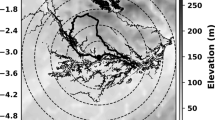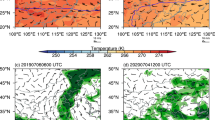Abstract
Rainfall prediction remains one of the most challenging problems in weather forecasting. In order to improve high-resolution quantitative precipitation forecasts (QPF), a new procedure for assimilating rainfall rate derived from radar composite reflectivity has been proposed and tested in a numerical simulation of the Chicago floods of 17–18 July 1996. The methodology is based on the one-dimensional variation scheme (1DVAR) assimilation approach introduced by Fillion and Errico but applied here using the Kain-Fritsch convective parameterization scheme (KF CPS). The novel feature of this work is the continuous assimilation of radar estimated rain rate over a three hour period, rather than a single assimilation at the initial (analysis) time. Most of the characteristics of this precipitation event, including the propagation, regeneration of mesoscale convective systems, the frontal boundary across the Midwest and the evolution of the low-level jet are better captured in the simulation as the radar-estimated precipitation rate is assimilated. The results indicate that precipitation assimilation during the early stage can improve the simulated mesoscale feature of the convection system and shorten the spin-up time significantly. Comparison of precipitation forecasts between the experiments with and without the 1DVAR indicates that the 1DVAR scheme has a positive impact on the QPF up to 36 hours in terms of the bias and bias equalized threat scores.
Similar content being viewed by others
References
Baldwin, M. E., and K. E. Mitchell, 1998: Progress on the NCEP hourly multi-sensor U.S. precipitation analysis for operations and GCIP research. Preprints, 2nd Symp. on Integrated Observing Systems, 78th AMS Annual Meeting, 10–11.
Barnes, S. L., 1964: A Technique for maximizing details in numerical weather map analysis. J. Appl. Meteor., 3, 396–409.
Changnon, S. A., and K. E. Kunkel, 1999: Record flood-producing rainstorms of 17–18 July 1996 in the Chicago Metropolitan Area. Part I: Synoptic and mesoscale features. J. Appl. Meteor., 38, 257–265.
Colle, B.A., C. F. Mass, and K. J. Westrick, 2000: MM5 precipitation verification over the Pacific Northwest during the 1997–99 cool seasons. Wea. Forecasting, 15, 730–744.
Dudhia, J., 1989: Numerical study of convection observed during the Winter Monsoon Experiment using a mesoscale two-dimensional model. J. Atmos. Sci., 46, 3077–3107.
Dudhia, J., 1993: A nonhydrostatic version of the Penn State/NCAR mesoscale model: Validation tests and the simulation of an Atlantic cyclone and cold front. Mon. Wea. Rev., 121, 1943–1519.
Dudhia, J., 1996: A multi-layer soil temperature model for MM5. Preprints, The Sixth PSU/NCAR Mesoscale Model Users’ Workshop, 22–24 July 1996, Boulder, Colorado, 49–50.
Fillion, L., and R. M. Errico, 1997: Variational assimilation of precipitation data using moist convective parameterization schemes: A 1D-Var study. Mon. Wea. Rev., 125, 2917–2942.
Fillion, L., and J.-F. Mahfouf, 2000: Coupling of moistconvective and stratiform precipitation processes for variational data assimilation. Mon. Wea. Rev., 128, 109–124.
Fillion, L., and S. Bélair, 2004: Tangent linear aspects of the Kain-Fritsch moist convective parameterization scheme. Mon. Wea. Rev., 132, 2477–2494.
Fritsch, J. M., and R. E. Carbone, 2004: Improving quantitative precipitation forecasts in the warm season: A USWRP research and development strategy. Bull. Amer. Meteor. Soc., 85, 955–965.
Fritsch, J. M., and Coauthors, 1998: Quantitative precipitation forecasting: Report of the eighth prospectus development team, U.S. Weather Research Program. Bull. Amer. Meteor. Soc., 79, 285–299.
Fulton, R. A., J. P. Breidenbach, D. J. Seo, D. A. Miller, and T. O’Bannon, 1998: The WSR-88D rainfall algorithm. Wea. Forecasting, 13, 377–395.
Garand, L., and C. Grassoti, 1995: Toward an objective analysis of rainfall rate combining observations and short-term forecast model estimates. J. Appl. Meteor. 34, 1962–1977.
Gilbert, J.-C., and C. Lemarechal, 1989: Some numerical experiments with variable-storage quasi-Newton algorithms. Mathematical Programming, 45, 407–435.
Grell, G. A., J. Dudhia, and D. R. Stauffer, 1994: A description of the fifth-generation Penn State/NCAR mesoscale model (MM5). NCAR Tech. Note TN- 398+STR, 122pp. [Available from UCAR Communications, P.O. Box 3000, Boulder, CO 80307, USA]
Hamill, T. S., 1999: Hypothesis tests for evaluating numerical precipitation forecasts. Wea. Forecasting, 14, 155–167.
Hammer, G. R., and P. M. Steurer, 1997: Data set documentation for hourly precipitation data. NOAA/NCDC TD3240 Documentation Series, Asheville, NC, 17 pp.
Hong, S.-Y., and H.-L. Pan, 1996: Nonlocal boundary layer vertical diffusion in a medium-range forecast model. Mon. Wea. Rev., 124, 2322–2339.
Kain, J. S., and J. M. Fritsch, 1990: A one-dimensional entraining-detraining plume model and its application in convective parameterization. J. Atmos. Sci. 47, 2784–2802.
Kain, J. S., and J. M. Fritsch, 1993: Convective parameterization for mesoscale models: The Kain-Fritsch scheme. The Representation of Cumulus Convection in Numerical Models, Meteor. Monogr., No. 46, Amer. Meteor. Soc., 165–170.
Manobianco, J., S. Koch, V. M. Karyampudi, and A. J. Negri, 1994: The impact of assimilating satellite-derived precipitation rates on numerical simulations of the ERICA IOP 4 cyclone. Mon. Wea. Rev., 122, 341–365.
Marécal, V., and J.-F. Mahfouf, 2000: Variational retrieval of temperature and humidity profiles from TRMM precipitation data. Mon. Wea. Rev., 128, 3853–3866.
Marécal, V., and J.-F. Mahfouf, 2002: Four-dimensional variational assimilation of total column water vapor in rainy areas. Mon. Wea. Rev., 130, 43–58.
Nagarajan, B., M. K. Yau, and L. Fillion, 2006: A numerical study of the 1996 Saguenay flood cyclone: Effect of assimilation of precipitation data on quantitative precipitation forecast. Mon. Wea. Rev., 134, 1371–1388.
Olson, D. A., N. W. Junker, and B. Korty, 1995: Evaluation of 33 years of quantitative precipitation forecasting at the NMC. Wea. Forecasting, 10, 498–511.
Rogalus, M. J. III, and F. L. Ogden, 2007: Comparison of GCIP and stage III radar rainfall estimates over the Mississippi River Basin for 1997. J. Hydrol., 341, 177–185.
Stauffer, D. R., and N. L. Seaman, 1990: Use of four-dimensional data assimilation in a limited-area mesoscale model. Part I: Experiments with synopticscale data. Mon. Wea. Rev., 118, 1250–1277.
Stoelinga, M., and Coauthors, 2003: Improvement of microphysical parameterization through observational verification experiments IMPROVE. Bull. Amer. Meteor. Soc., 84, 1807–1826.
Tao, W.-K., J. Simpson, and M. McCumber, 1989: Icewater saturation adjustment. Mon. Wea. Rev., 117, 231–235.
Tao, W.-K., and J. Simpson, 1993: Goddard cumulus ensemble model. Part I: model description. Terrestrial, Atmospheric and Oceanic Sciences, 4, 35–72.
Author information
Authors and Affiliations
Corresponding author
Rights and permissions
About this article
Cite this article
Wang, X., Yau, M.K., Nagarajan, B. et al. The impact of assimilating radar-estimated rain rates on simulation of precipitation in the 17–18 July 1996 Chicago floods. Adv. Atmos. Sci. 27, 195–210 (2010). https://doi.org/10.1007/s00376-009-8212-6
Received:
Revised:
Published:
Issue Date:
DOI: https://doi.org/10.1007/s00376-009-8212-6




